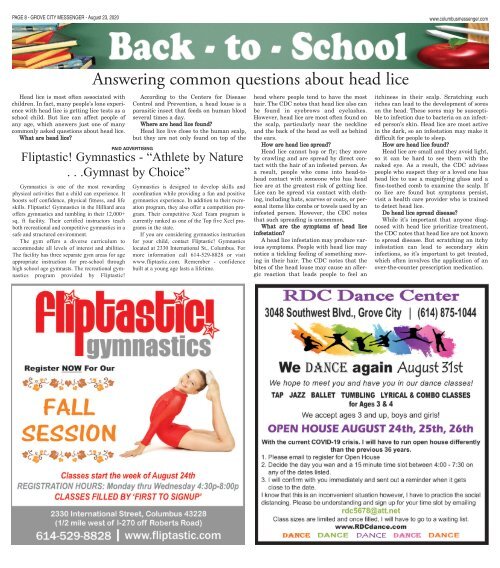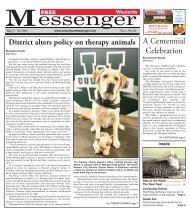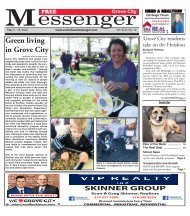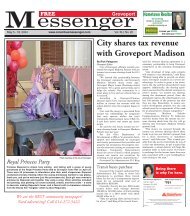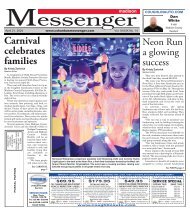Create successful ePaper yourself
Turn your PDF publications into a flip-book with our unique Google optimized e-Paper software.
PAGE 8 - GROVE CITY MESSENGER - <strong>August</strong> 23, <strong>2020</strong><br />
www.columbusmessenger.com<br />
Head lice is most often associated with<br />
children. In fact, many people’s lone experience<br />
with head lice is getting lice tests as a<br />
school child. But lice can affect people of<br />
any age, which answers just one of many<br />
commonly asked questions about head lice.<br />
What are head lice?<br />
Gymnastics is one of the most rewarding<br />
physical activities that a child can experience. It<br />
boosts self confidence, physical fitness, and life<br />
skills. Fliptastic! Gymnastics in the Hilliard area<br />
offers gymnastics and tumbling in their 12,000+<br />
sq. ft facility. Their certified instructors teach<br />
both recreational and competitive gymnastics in a<br />
safe and structured environment.<br />
The gym offers a diverse curriculum to<br />
accommodate all levels of interest and abilities.<br />
The facility has three separate gym areas for age<br />
appropriate instruction for pre-school through<br />
high school age gymnasts. The recreational gymnastics<br />
program provided by Fliptastic!<br />
Answering common questions about head lice<br />
According to the Centers for Disease<br />
Control and Prevention, a head louse is a<br />
parasitic insect that feeds on human blood<br />
several times a day.<br />
Where are head lice found?<br />
Head lice live close to the human scalp,<br />
but they are not only found on top of the<br />
PAID ADVERTISING<br />
Fliptastic! Gymnastics - “Athlete by Nature<br />
. . .Gymnast by Choice”<br />
Gymnastics is designed to develop skills and<br />
coordination while providing a fun and positive<br />
gymnastics experience. In addition to their recreation<br />
program, they also offer a competition program.<br />
Their competitive Xcel Team program is<br />
currently ranked as one of the Top five Xcel programs<br />
in the state.<br />
If you are considering gymnastics instruction<br />
for your child, contact Fliptastic! Gymnastics<br />
located at 2330 International St., Columbus. For<br />
more information call 614-529-8828 or visit<br />
www.fliptastic.com. Remember - confidence<br />
built at a young age lasts a lifetime.<br />
head where people tend to have the most<br />
hair. The CDC notes that head lice also can<br />
be found in eyebrows and eyelashes.<br />
However, head lice are most often found on<br />
the scalp, particularly near the neckline<br />
and the back of the head as well as behind<br />
the ears.<br />
How are head lice spread?<br />
Head lice cannot hop or fly; they move<br />
by crawling and are spread by direct contact<br />
with the hair of an infested person. As<br />
a result, people who come into head-tohead<br />
contact with someone who has head<br />
lice are at the greatest risk of getting lice.<br />
Lice can be spread via contact with clothing,<br />
including hats, scarves or coats, or personal<br />
items like combs or towels used by an<br />
infested person. However, the CDC notes<br />
that such spreading is uncommon.<br />
What are the symptoms of head lice<br />
infestation?<br />
A head lice infestation may produce various<br />
symptoms. People with head lice may<br />
notice a tickling feeling of something moving<br />
in their hair. The CDC notes that the<br />
bites of the head louse may cause an allergic<br />
reaction that leads people to feel an<br />
itchiness in their scalp. Scratching such<br />
itches can lead to the development of sores<br />
on the head. These sores may be susceptible<br />
to infection due to bacteria on an infected<br />
person’s skin. Head lice are most active<br />
in the dark, so an infestation may make it<br />
difficult for people to sleep.<br />
How are head lice found?<br />
Head lice are small and they avoid light,<br />
so it can be hard to see them with the<br />
naked eye. As a result, the CDC advises<br />
people who suspect they or a loved one has<br />
head lice to use a magnifying glass and a<br />
fine-toothed comb to examine the scalp. If<br />
no lice are found but symptoms persist,<br />
visit a health care provider who is trained<br />
to detect head lice.<br />
Do head lice spread disease?<br />
While it’s important that anyone diagnosed<br />
with head lice prioritize treatment,<br />
the CDC notes that head lice are not known<br />
to spread disease. But scratching an itchy<br />
infestation can lead to secondary skin<br />
infections, so it’s important to get treated,<br />
which often involves the application of an<br />
over-the-counter prescription medication.


